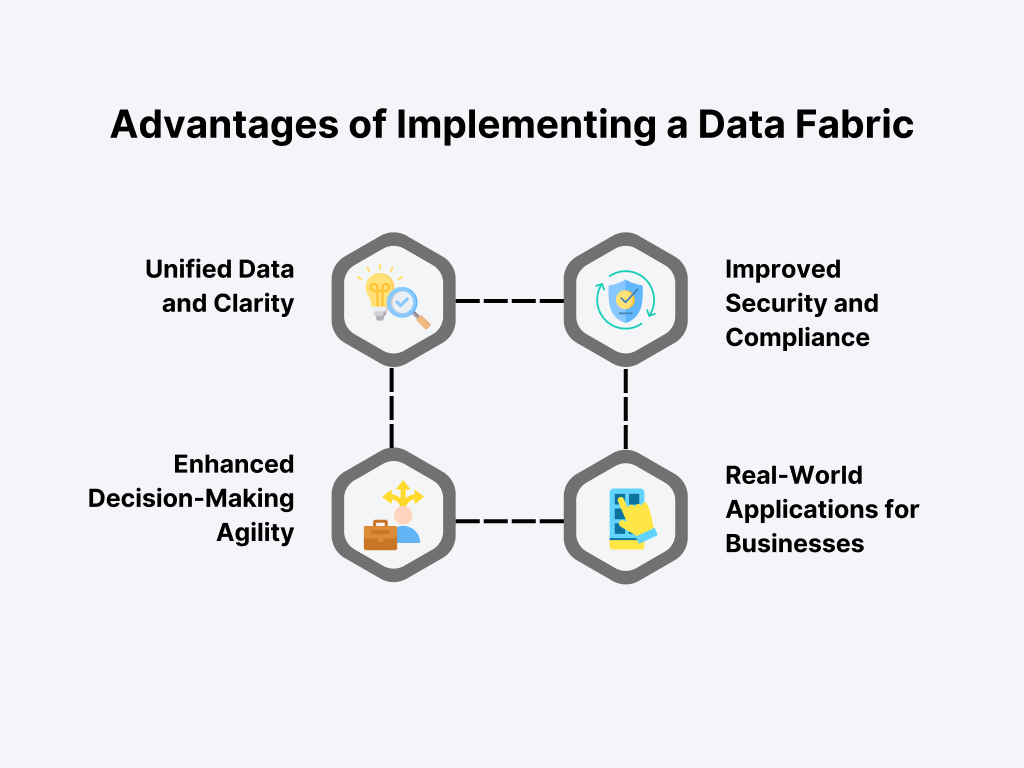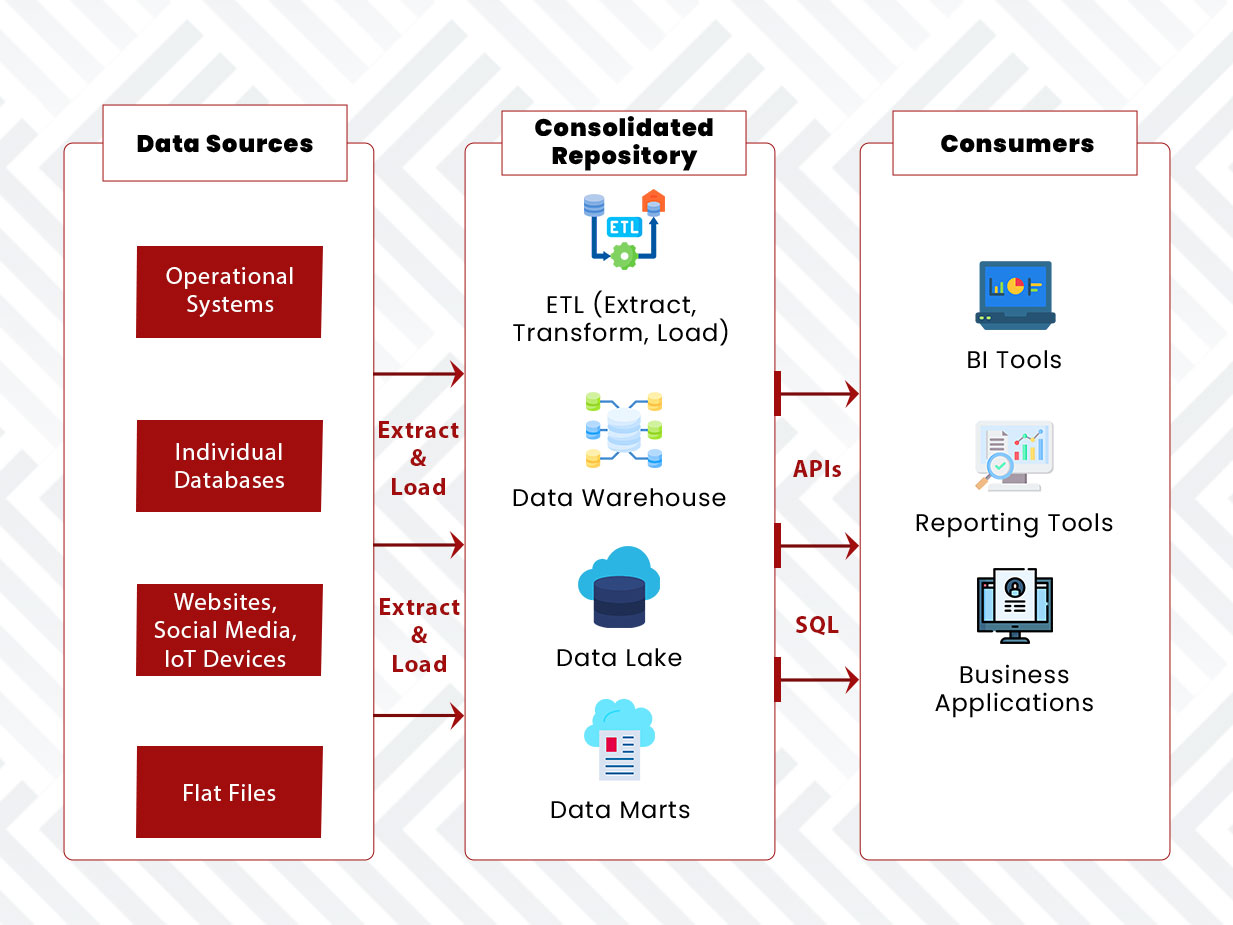
Building a Data Fabric: From Silos to Insights
Learn how to make the most of your business’s data and see how a data fabric can help.
Large global companies often have big data teams that manage and share data using systems like a data mesh. But medium-sized businesses are also dealing with complicated data setups. They're finding that keeping data separate in different sections can hold them back. For these businesses, using a centralized data fabric might be a smarter way to handle their data.
What is a data fabric?
A data fabric is a centralized method of managing data designed to make handling and accessing data easier. Gartner defines a data fabric as a way to illustrate how different data sources can work together to enhance decision-making. Unlike a decentralized, domain-driven data mesh focused on distributed ownership and governance, a data fabric offers a simpler, more traditional architecture that eases data management challenges.
Advantages of Implementing a Data Fabric

- Unified Data and Clarity: A data fabric consolidates data into a single central repository, ensuring that employees across different departments access the same information. This uniformity allows for easier data analysis and ensures all departments make decisions based on the same set of data, promoting consistency and clarity.
- Enhanced Decision-Making Agility: Centralized control through a data fabric allows businesses to quickly obtain and analyze relevant data, facilitating faster decision-making. Integrating machine learning and analytics on a unified platform can further boost business intelligence, giving agile companies a competitive edge over larger, slower-moving rivals.
- Improved Security and Compliance: A data fabric simplifies the enforcement of security policies and compliance requirements by providing a centralized governance platform. This centralization facilitates secure integrations, user management, detailed logging, and compliance, all overseen by a dedicated data management team.
- Real-World Applications for Businesses: For businesses like e-commerce startups, a data fabric integrates customer data from various sources—online sales platforms, marketing tools, and customer service systems. This integrated view allows businesses to analyze consumer behaviors and pinpoint areas for improvement, enhancing marketing strategies and customer satisfaction, and driving overall growth.
Understanding Data Fabric in a Professional Context
A data fabric integrates various data sources across an organization into a unified system, providing a comprehensive view that enhances understanding of customer behaviors and business operations. This holistic perspective is crucial for improving customer loyalty and precisely evaluating the return on investment (ROI) for specific interactions.
For instance, if a company lands a significant contract with a new client, initial profit calculations might consider direct expenses like materials, labor, and marketing. However, if the client later requires extensive post-sale support, these costs could erode the expected profits. A data fabric enables continuous monitoring of these costs, ensuring a more accurate assessment of customer profitability.
Challenges and Opportunities with Data Fabric Implementation

Implementing a data fabric can be challenging, particularly due to data silos within organizations. These silos hinder the free flow of information and complicate the achievement of a unified data overview, which is essential for the data fabric to function effectively.
Consider a scenario where a company's sales data is stored in Salesforce, while customer support data resides in Zendesk. If these systems are not integrated, it can lead to a fragmented understanding of customer issues, especially as contracts come up for renewal. This lack of integration can obscure critical information, such as customer satisfaction and additional service needs.
However, successfully integrating disparate data systems can convert these potential setbacks into strategic advantages. For example, if integrated data reveals that a customer inquired about a new feature during a support call, this insight could provide a sales opportunity, turning a cost-heavy interaction into a profitable engagement. By overcoming these integration challenges, a data fabric not only enhances customer service but also opens up new revenue avenues, transforming isolated data into valuable business insights.
Guide to Implementing a Data Fabric: A Step-by-Step Approach
1. Choose the Right Technology: Start by selecting a data integration platform that is intuitive and includes all necessary connectors. This platform should simplify the extraction, loading, and transformation of data from various sources into a centralized repository.
2. Shift Organizational Culture: Beyond technology, changing the company culture towards open data sharing and collaboration is essential. Promote the benefits of a unified data management approach to foster a cooperative environment across departments.
3. Establish a Data Centre of Excellence (DCoE): Set up a DCoE to oversee data governance, standards, and best practices. This entity will ensure the integrity and reliability of the data repository and enforce consistent data definitions and metrics throughout the organization.
Embracing Modern Data Management
Accropolix is enhancing its data management capabilities with a data fabric, streamlining data integration and enabling informed decision-making. This technology consolidates data across the organization, improving security and operational efficiency while allowing swift adaptation to market changes.
Adopting a data fabric transforms our approach to managing data, turning it into a strategic asset that supports innovation and competitive advantage in the digital economy. This strategic move aligns with Accropolix's broader business goals, ensuring agility and responsiveness in a rapidly evolving marketplace.


